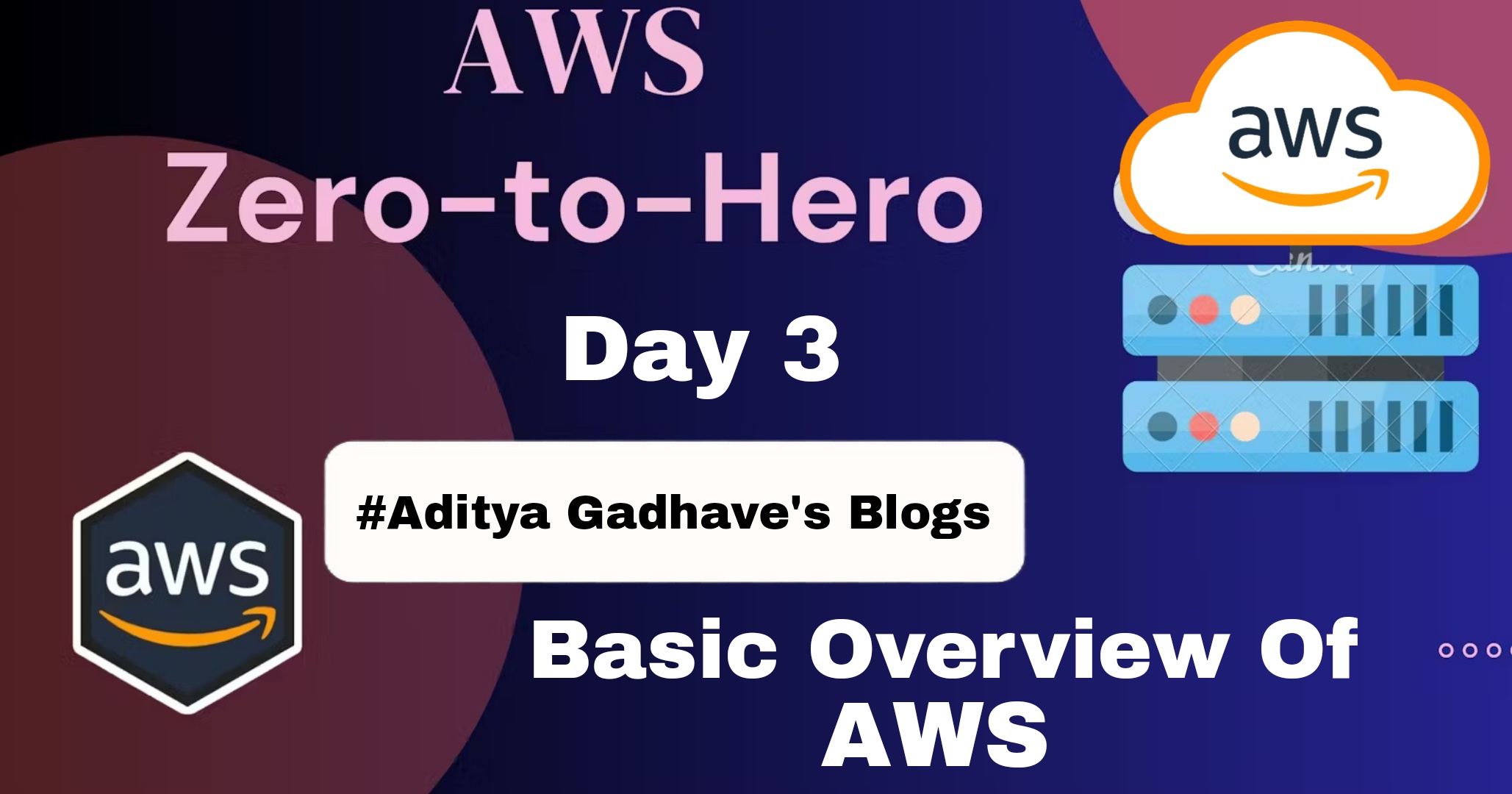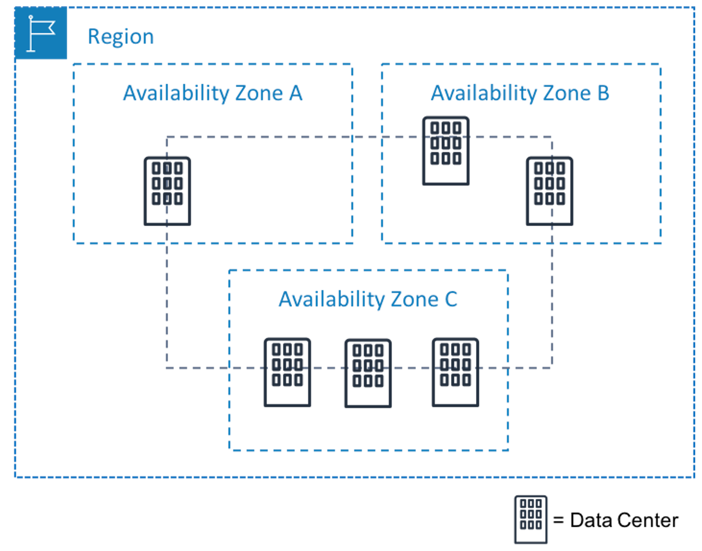Understanding the Basics of Amazon Web Services
 Aditya Gadhave
Aditya Gadhave
What is AWS?
AWS stands for Amazon Web Services.
The AWS service is provided by the Amazon that uses distributed IT infrastructure to provide different IT resources available on demand.
It provides different services such as infrastructure as a service (IaaS), platform as a service (PaaS) and packaged software as a service (SaaS).
Amazon launched AWS, a cloud computing platform to allow the different organizations to take advantage of reliable IT infrastructure.
Uses of AWS
A small manufacturing organization uses their expertise to expand their business by leaving their IT management to the AWS.
A large enterprise spread across the globe can utilize the AWS to deliver the training to the distributed workforce.
An architecture consulting company can use AWS to get the high-compute rendering of construction prototype.
A media company can use the AWS to provide different types of content such as ebox or audio files to the worldwide files.
Pay-As-You-Go
Based on the concept of Pay-As-You-Go, AWS provides the services to the customers.
AWS provides services to customers when required without any prior commitment or upfront investment.
Pay-As-You-Go enables the customers to procure services from AWS.
Computing
Programming models
Database storage
Networking

History of AWS

2003: In 2003, Chris Pinkham and Benjamin Black presented a paper on how Amazon's own internal infrastructure should look like. They suggested to sell it as a service and prepared a business case on it. They prepared a six-page document and had a look over it to proceed with it or not. They decided to proceed with the documentation.
2004: SQS stands for "Simple Queue Service" was officially launched in 2004. A team launched this service in Cape Town, South Africa.
2006: AWS (Amazon Web Services) was officially launched.
2007: In 2007, over 180,000 developers had signed up for the AWS.
2010: In 2010, amazon.com retail web services were moved to the AWS, i.e., amazon.com is now running on AWS.
2011: AWS suffered from some major problems. Some parts of volume of EBS (Elastic Block Store) was stuck and were unable to read and write requests. It took two days for the problem to get resolved.
2012: AWS hosted a first customer event known as re:Invent conference. First re:invent conference occurred in which new products were launched. In AWS, another major problem occurred that affects many popular sites such as Pinterest, Reddit, and Foursquare.
2013: In 2013, certifications were launched. AWS started a certifications program for software engineers who had expertise in cloud computing.
2014: AWS committed to achieve 100% renewable energy usage for its global footprint.
2015: AWS breaks its revenue and reaches to $6 Billion USD per annum. The revenue was growing 90% every year.
2016: By 2016, revenue doubled and reached $13Billion USD per annum.
2017: In 2017, AWS re: invent releases a host of Artificial Intelligence Services due to which revenue of AWS doubled and reached $27 Billion USD per annum.
2018: In 2018, AWS launched a Machine Learning Speciality Certs. It heavily focussed on automating Artificial Intelligence and Machine learning.
Benefits of AWS:
Scalability: AWS allows resources to scale up or down depending on demand, ensuring cost efficiency.
Cost-Effectiveness: Pay-as-you-go model ensures you only pay for the services you use.
Global Availability: AWS provides infrastructure in multiple regions around the world, allowing businesses to deploy globally.
Security: AWS offers robust security features, including encryption, monitoring, and compliance with industry standards.
Advantages of AWS Cloud:
Scalability:
- AWS enables you to scale resources up or down based on demand, allowing businesses to handle traffic spikes without overprovisioning.
Cost-Effectiveness:
- With a pay-as-you-go model, AWS ensures you only pay for what you use, eliminating the need for upfront investments in hardware.
Global Reach:
- AWS has data centers in multiple regions worldwide, allowing businesses to deploy applications globally and reduce latency for users.
Security:
- AWS offers strong security features, including encryption, access control, compliance with various certifications (e.g., ISO, HIPAA, GDPR), and services like IAM and AWS Shield for DDoS protection.
Wide Range of Services:
- AWS provides a broad spectrum of services, from computing, storage, and networking to databases, machine learning, analytics, and IoT, catering to diverse business needs.
Reliability and Uptime:
- AWS guarantees high availability with its architecture of multiple Availability Zones (AZs), ensuring minimal downtime and business continuity.
Fast Deployment:
- Businesses can quickly deploy and manage applications using AWS services like EC2, Lambda, and Elastic Beanstalk, reducing time to market.
Innovation:
- AWS constantly updates its platform, providing access to cutting-edge technologies, including AI, machine learning, and serverless computing.
Disadvantages of AWS Cloud:
Complex Pricing Structure:
- AWS’s pricing can be confusing due to the large number of services, billing metrics, and options available, which can make it difficult to estimate costs accurately.
Learning Curve:
- While AWS offers vast capabilities, it requires technical expertise to manage and fully leverage its services, which can be overwhelming for new users.
Data Transfer Costs:
- Although AWS offers low-cost storage and compute services, data transfer fees (especially for moving data out of AWS) can accumulate and become expensive.
Vendor Lock-In:
- Migrating applications and data to another provider after adopting AWS services can be complex and costly, potentially leading to vendor lock-in.
Technical Support Costs:
- While AWS offers support plans, high-quality support options can be expensive, especially for businesses needing enterprise-level assistance.
Custom Configuration Challenges:
- Managing and configuring AWS services to meet specific business needs can require significant expertise in cloud architecture, especially for complex environments.
Service Limits:
- AWS imposes service limits on certain resources by default (e.g., EC2 instances), and increasing these limits requires submitting requests and approvals.
AWS Global Infrastructure
AWS is a cloud computing platform which is globally available.
Global infrastructure is a region around the world in which AWS is based. Global infrastructure is a bunch of high-level IT services which is shown below:
AWS is available in 19 regions, and 57 availability zones in December 2018 and 5 more regions 15 more availability zones for 2019.
The following are the components that make up the AWS infrastructure:
Availability Zones
Region
Edge locations
Regional Edge Caches

Availability zone as a Data Center
An availability zone is a facility that can be somewhere in a country or in a city. Inside this facility, i.e., Data Centre, we can have multiple servers, switches, load balancing, firewalls. The things which interact with the cloud sits inside the data centers.
An availability zone can be a several data centers, but if they are close together, they are counted as 1 availability zone.
Region
A region is a geographical area. Each region consists of 2 more availability zones.
A region is a collection of data centers which are completely isolated from other regions.
A region consists of more than two availability zones connected to each other through links.

- Availability zones are connected through redundant and isolated metro fibers.

The AWS Cloud spans 108 Availability Zones within 34 geographic regions.
With announced plans for 18 more Availability Zones and six more AWS Regions in Mexico, New Zealand, the Kingdom of Saudi Arabia, Thailand, Taiwan, and the AWS European Sovereign Cloud.
Here are some examples of AWS regions and availability zones:
us-east-1a: An availability zone in the U.S. East (Northern Virginia) region
af-south-1a, af-south-1b, af-south-1c: Three availability zones in the Africa (Cape Town) region
us-west-1: An availability zone in the US West (N. California) region
ap-south-1: An availability zone in the Asia Pacific (Mumbai) region
Edge Locations
Edge locations are the endpoints for AWS used for caching content.
Edge locations consist of CloudFront, Amazon's Content Delivery Network (CDN).
Edge locations are more than regions. Currently, there are over 150 edge locations.
Edge location is not a region but a small location that AWS have. It is used for caching the content.
Edge locations are mainly located in most of the major cities to distribute the content to end users with reduced latency.
For example, some user accesses your website from Singapore; then this request would be redirected to the edge location closest to Singapore where cached data can be read.
Regional Edge Cache
AWS announced a new type of edge location in November 2016, known as a Regional Edge Cache.
Regional Edge cache lies between CloudFront Origin servers and the edge locations.
A regional edge cache has a large cache than an individual edge location.
Data is removed from the cache at the edge location while the data is retained at the Regional Edge Caches.
When the user requests the data, then data is no longer available at the edge location. Therefore, the edge location retrieves the cached data from the Regional edge cache instead of the Origin servers that have high latency.
Conclusion:
Amazon Web Services (AWS) is a comprehensive cloud computing platform offering a wide range of services such as computing power, storage, and databases on a flexible, on-demand basis. AWS revolutionizes traditional IT infrastructure by eliminating the need for physical servers and allowing businesses to scale resources up or down easily. With a focus on innovation and robust security measures, AWS empowers organizations of all sizes to optimize costs, accelerate development, and enhance operational efficiency.
If you have any questions, need clarifications, or want to discuss anything related to AWS technologies, feel free to reach out to me on LinkedIn. Connect with me at Aditya Gadhave, and I'll be more than happy to assist you. 😊
Subscribe to my newsletter
Read articles from Aditya Gadhave directly inside your inbox. Subscribe to the newsletter, and don't miss out.
Written by

Aditya Gadhave
Aditya Gadhave
👋 Hello! I'm Aditya Gadhave, an enthusiastic Computer Engineering Undergraduate Student. My passion for technology has led me on an exciting journey where I'm honing my skills and making meaningful contributions.